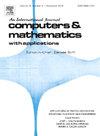A pressure-robust lowest-order virtual element method for the natural convection problem on general mesh
IF 2.5
2区 数学
Q1 MATHEMATICS, APPLIED
引用次数: 0
Abstract
In this article, our focus lies on the natural convection model, which is formulated by coupling the incompressible Navier-Stokes equations with the heat equation. However, the traditional mixed finite element method applied to the incompressible Navier-Stokes equations has certain limitations: it tends to relax the divergence constraint, resulting in a lack of sufficient robustness when dealing with large irrotational forces in momentum balance, and the velocity errors inherent in those methods are often closely related to the continuous pressure, which in turn further compromise numerical accuracy. To address these issues, we propose a pressure-robust lowest-order mixed virtual element method for natural convection problem on general mesh. We employed a -conforming virtual element space which can provide a point-wise discrete divergence-free velocity, and through the reconstruction of velocity test function and compatibility with the Helmholtz-Hodge decomposition, the influence of continuous pressure on velocity field is eliminated and the numerical oscillations caused by large irrotational body force term in momentum balance are overcome. We rigorously prove the -error estimates for the velocity and temperature fields, as well as the -error estimate for the pressure field. We then conduct numerical experiments to verify the accuracy of the theory and the effectiveness of our proposed method.
一般网格自然对流问题的压力鲁棒性最低阶虚元法
在本文中,我们的重点在于自然对流模型,该模型是由不可压缩的Navier-Stokes方程与热方程耦合而成的。然而,传统的用于不可压缩Navier-Stokes方程的混合有限元方法存在一定的局限性:它容易放松散度约束,导致在处理动量平衡中较大的无旋力时缺乏足够的鲁棒性,并且这些方法固有的速度误差往往与连续压力密切相关,从而进一步影响数值精度。为了解决这些问题,我们提出了一种压力鲁棒的一般网格自然对流问题的最低阶混合虚元方法。采用符合h1的可提供逐点离散无散度速度的虚元空间,通过速度测试函数的重构和与Helmholtz-Hodge分解的兼容,消除了连续压力对速度场的影响,克服了动量平衡中较大的非旋转体力项引起的数值振荡。我们严格证明了速度场和温度场的h1误差估计,以及压力场的l2误差估计。然后,我们进行了数值实验来验证理论的准确性和所提出方法的有效性。
本文章由计算机程序翻译,如有差异,请以英文原文为准。
求助全文
约1分钟内获得全文
求助全文
来源期刊

Computers & Mathematics with Applications
工程技术-计算机:跨学科应用
CiteScore
5.10
自引率
10.30%
发文量
396
审稿时长
9.9 weeks
期刊介绍:
Computers & Mathematics with Applications provides a medium of exchange for those engaged in fields contributing to building successful simulations for science and engineering using Partial Differential Equations (PDEs).
 求助内容:
求助内容: 应助结果提醒方式:
应助结果提醒方式:


